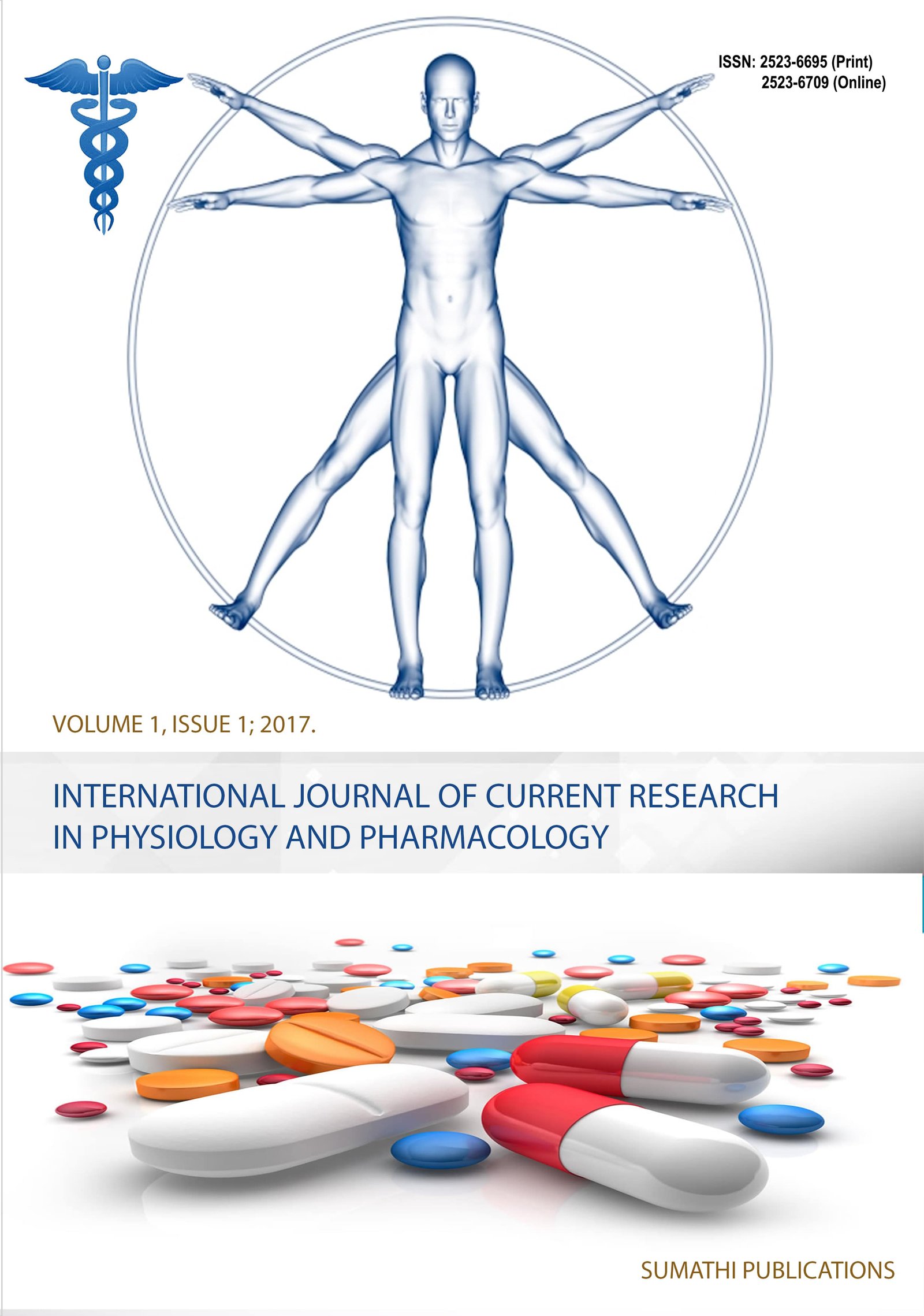“SUPPLEMENTATION OF ZINC IN ACUTE AND CHRONIC HEAT STRESS ON ANTIOXIDANT CHANGES IN WISTAR ALBINO RATS”
DOI:
https://doi.org/10.31878/ijcrpp.2020.41.04Keywords:
antioxidants, heat stress, wistar albino ratsAbstract
ABSTRACT:
Introduction: Heat stress is a major health burden with potential health out-comes. Oxidative stress is a metabolic dysfunction that carries oxidative damage of cells and tissues. Zinc is a co-factor against oxidative stress. Aim: The present study was done to evaluate the Supplementation of zinc in acute and chronic heat stress on antioxidant changes in wistar albino rats. Methodology: 36 Wistar albino rats were selected for the study. They were divided into 2 Groups. Group A was acutely and Group B was chronically heat stressed rats and both were zinc pretreated. The Enzymatic and Non enzyme activity in them were estimated.
Results: After acute and chronic heat stress, i) there was a significant increase (P <0.001) in lipid peroxidation activity. ii) Enzymatic and Non-enzymatic antioxidants were reduced (P < 0.001) iii) Rats pretreated with zinc showed a decrease (P< 0.001) in lipid peroxidation and increase (P < 0.001) in enzymatic antioxidants (P < 0.001) and Non enzymatic antioxidants.
Key Words: antioxidants, heat stress, wistar albino rats
Downloads
References
Moberg GP. Biological Response to stress: key to assessment of animal well-being? In: G.P.Moberg (ed.) Animal stress. American Physiological Society publication.1980; 27-49.
Albert PC, Chan, Wen Yi. Heat stress and its impacts on occupational health and performance, Indoor and built evnvironment.2016;25 (1) 3-5.
Sapolsky RM, Romero LM, Munck AU. How do glucocorticoids influence stress responses? Integrating permissive, suppressive, stimulatory, and preparative actions. Endocr. Rev. 2000;21:55-89.
Moberg GP. Biological response to stress: Implication for animal welfare. In: G.P. Moberg and GA Mench. The biology of animal stress.2000;123-146.
King JC, Shames DM, Woodhouse LR. Zinc homeostasis in humans. J Nutr 2000;130: 1360S–6S.
Jackson MJ. Physiology of Zinc: general aspects. In: Mills CF, Editor. Zinc in human biology. London: Springer.1989;1–14.
Fosmire GJ. Zinc toxicity. American Journal of Clinical Nutrition. 1990;51:225–7.
Jackson MJ, Jones DA, Edwards RH. Tissue zinc levels as an index of body zinc status. Clinical Physiology. 1982;2:333–43.
Prasad AS. Clinical, immunological, anti-inflammatory and antioxidant roles of zinc. Experimental Gerontol. 2008; 43: 370–7.
Butterfield DA, Domenico FB. Elevated risk of type 2 diabetes for development of Alzheimer disease: A key role for oxidative stress in brain. Biochim. 2014;1824:1693–1706.
Feng B, Ruiz MA. Oxidative-stress-induced epigenetic changes in chronic diabetic complications. Can. J. Physiol. Pharmacol. 2013;91:213–20.
Pisoschi AM, Pop A. The role of antioxidants in the chemistry of oxidative stress: A review. Eur. J. Med. Chem. 2015;97:55–74
Korichneva I. Zinc dynamics in the myocardial redox signaling network. Antioxidant Redox Signal 2006;8:1707–21.
Ohkawa H, Ohishi N, Yagi K. Assay for lipid peroxides in animal tissues by thiobarbituric acid reaction. Anal Biochem. 1979; 95(2):351-8
Marklund S, Marklund G. Involvement of the Superoxide Anion Radical in the Autoxidation of Pyrogallol and a Convenient Assay for Superoxide Dismutase. European Journal of Biochemistry.1974;47: 469-74.
Rotruck JT, Pope AL, Ganther HE, Swanson AB, Hafeman DG, Hoekstra WG. Article title. Science, 1973;179:588-90.
Sinha AK. Colorimetric Assay of Catalase. Analytical Biochemistry.1972; 47:389-94.
Omaye ST, Turnbull JD, Sauberlich HE. Selected Methods for the Determination of Ascorbic Acid in Animal Cells, Tissues, and Fluids. Methods in Enzymology.1979;62: 3-11
Desai ID, Vitamin E analysis methods for animal tissues. Methods Enzymol. 1984;105:138-47
Mendoza SP, Capitanio JP, Mason WA. Chronic Social Stress: Studies in Non-human Primates. 2000; 23:227-47
Wang RR, Pan XJ, Peng ZQ. Effects of heat exposure on muscle oxidation and protein functionalities of pectoralis major in broilers. Poultry Science. 2009; 88:1078–84
Günther V, Lindert U. The taste of heavy metals: Gene regulation by MTF-1. Biochem. Biophys. Acta. 2012;1823:1416–25.
Bonaventura P, Benedetti G. Zinc and its role in immunity and inflammation. Autoimmunity Rev. 2015;14:277–85.
Sekler I, Sensi SL. Mechanism and regulation of cellular zinc transport. Molecular Medicine. 2007;13:337–43.
Downloads
Published
How to Cite
Issue
Section
License
Copyright (c) 2020 antony madhuri bedadala; Dr Anthony David, DOCTOR

This work is licensed under a Creative Commons Attribution-NonCommercial-ShareAlike 4.0 International License.
The journal allows the author(s) to hold the copyright without restrictions and will retain publishing rights without restrictions.
The submitted papers are assumed to contain no proprietary material unprotected by patent or patent application; responsibility for technical content and for protection of proprietary material rests solely with the author(s) and their organizations and is not the responsibility of the journal. The main (first/corresponding) author is responsible for ensuring that the article has been seen and approved by all the other authors. It is the responsibility of the author to obtain all necessary copyright release permissions for the use of any copyrighted materials in the manuscript prior to the submission.
What are my rights as an author?
It is important to check the policy for the journal to which you are submitting or publishing to establish your rights as
Author. Journal's standard policies allow the following re-use rights:
- The journal allows the author(s) to hold the copyright without restrictions.
- The journal allows the author(s) to obtain publishing rights without restrictions.
- You may do whatever you wish with the version of the article you submitted to the journal.
- Once the article has been accepted for publication, you may post the accepted version of the article on your own personal website, your department's website or the repository of your institution without any restrictions.
- You may not post the accepted version of the article in any repository other than those listed above (i.e. you may not deposit in the repository of another institution or a subject-matter repository) until 12 months after publication of the article in the journal.
- You may use the published article for your own teaching needs or to supply on an individual basis to research colleagues, provided that such supply is not for commercial purposes.









